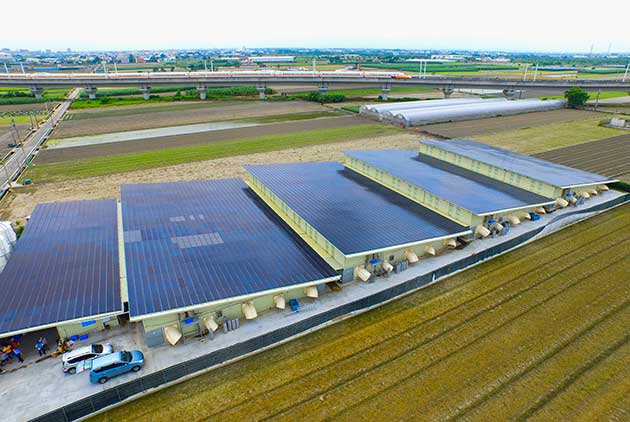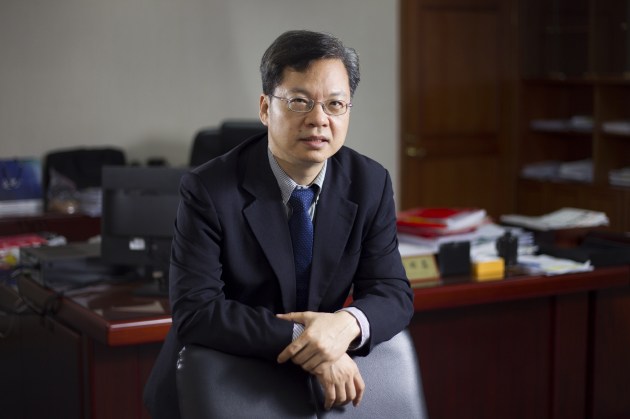Can Small Investments Create Large Returns for Energy Production?

Source:Kuo-Tai Liu
Incoming Premier William Lai is wasting no time, cracking the whip to jumpstart Taiwan’s ambitious new infrastructure program, focusing on green energy, offshore wind farms, digital infrastructure upgrading, and easing employment regulations. Will the government’s strategy of using small investment to stimulate large growth pay off?
Views
Can Small Investments Create Large Returns for Energy Production?
By Peihua LuFrom CommonWealth Magazine (vol. 637 )
Taiwan’s Forward-Looking Infrastructure Development Program, which earmarks over NT$100 billion in government investment by the end of 2018, kicked off in September. According to projections from the Directorate General of Budget, Accounting and Statistics (DGBAS), the program will contribute a 0.1 percent uptick in year-on GDP growth.
“That estimate is too conservative,” states Kung Ming-hsin, former deputy minister of the National Development Council and current deputy minister of Economic Affairs.
This is because the government is only putting a small amount of funding into green energy and digital infrastructure development itself, leaving the bulk of investment to private enterprise.
Taking the example of offshore wind farms, the government is only footing the bill for wharf overhauls, with vendors responsible for development and any losses or profits. The National Development Council has estimated that NT$800 billion over eight years can drive NT$1.7 trillion in private investment.
Heads of finance have the deepest appreciation for just how hot an item green energy is now. One forum on renewable energy after another took place in the latter half of 2017, and as National Development Council deputy minister Tseng Shu-cheng observes, “A number of overseas vendors have already come to Taiwan to test the waters.”
8 billion NTD has been set aside for the first phase of green energy development, to go into research and development of renewable energy, with offshore wind farms and solar energy the key areas of focus.
True to his roots as a local politician, shortly upon assuming office, Premier William Lai called for increasing the scope of renewable energy and faster progress, e.g. aiming for the generation of 5.5 Gigawatts of power instead of 3.0 GW from offshore wind farms by 2025, and 3.0 GW of production from rooftop solar panels five years earlier than previously planned.
‘Farming’ Energy on Land and Water
How will this be accomplished? The government is beginning with a systemic approach, providing vendors with incentives.
In order to attract participation from operations firms in the recently announced National Rooftop Energy Production Project, the Bureau of Energy wants Taipower to raise its purchase rate to six percent for high-efficiency modules, and 15 percent for units installed in northern Taiwan.
In the past, vendors had to negotiate with private residents one by one to lease their rooftop spaces. Now, the central government has tasked local governments to go out and conduct inventory. Following consolidation of the findings, each district will be tasked with generating at least 50 MW, or around 5,000 household rooftops, with vendors competing directly for accounts. Kung explains that, as economy of scale grows, installation costs for vendors will drop, which in turn should entice more and more businesses to enter the field. Businesses must also return those savings to their local governments.
Offshore wind farms are being greeted with even higher expectations. Taiwan lacks sufficient know-how - from technical to financing- yet the infrastructure project mandates that Taiwanese parts must be used.
Moreover, due to delays in environmental impact assessments, only one of three pilot offshore wind farms, Shangwei, has managed to commence commercial operations, producing power since April of 2017. Meanwhile, progress on another such project, Fuhai, remains hung up by environmental impact assessments. And the third one, by Taipower, despite clearing the way for wind farms, has seen three consecutive bids fail in its search for experienced vendors due to unattractive prices.
In the race against time, the Ministry of Economic Affairs (MOEA) has relaxed the mandate on the use of Taiwanese-made parts and components in the supply chain. Meanwhile, Taipower has upped the ante from NT$19.5 billion to NT$25 billion, hoping to secure vendors to enable the swift construction of 22 planned offshore wind turbines projected to produce 110 MW of power.
Wellington Koo, chairman of the Financial Supervisory Commission, has overseen regulatory easing on multiple levels, from credit to investment to the application process. For example, the customer revenue for branches of overseas banks was originally set at a minimum of NT$35 billion, which can now be waived due to investment in offshore wind farms. Koo states that experienced foreign banks can thus take the lead, providing valuable project financing experience for local banks.
Elevating Digital Development
Another undertaking with significant potential economic impact is digital development, for which the budget is largely concentrated on broadband and smart city development.
Tseng relates that the government’s goal is to achieve one-gigabyte broadband in every town and city, and 100 megabytes in every village, to pave the way for the development of such digital infrastructure as remote healthcare and remote learning. The MOEA has also earmarked a budget to subsidize local governments or businesses investing in the government’s Smart Cities Program.
“For example, an investment of NT$10 million will include NT$6 million from the company that won the bid. And this does not even take into account the trickle-down effect that can benefit industry, where vendors need to purchase equipment and facilities, and equipment, parts and components suppliers also benefit,” notes Koo.
Regulatory Easing: Attracting Professionals to Taiwan
Other than facilities development, as the Democratic Progressive Party (DPP) enters its second year in power, various regulations have been eased, passed, or are under review by the Legislative Yuan. Among these are the Act for the Recruitment and Employment of Foreign Professional Talent, the Financial Technology Innovative Experiment Act, and the revision of the Statutes for Industrial Innovation, to encourage venture capital investment in startups.
According to Tseng, the Act for the Recruitment and Employment of Foreign Professional Talent could be in place as early as before the Lunar New Year in 2018 (note: The Lunar New Year falls on February 16 in 2018). In the future, foreign nationals working in Taiwan in such occupations as foreign language teachers, athletic coaches, or the visual or performing arts need not wait for their employer to complete an application before coming to Taiwan, but can apply for an employment-seeking visa and come to Taiwan directly to look for work.
In the future, the regulatory sandbox, which allows innovators to test their products and business models, will not apply only to financial services. In fact, the MOEA is working on revising the SME Development Statute to include a “sandbox mechanism.” For its part, the Ministry of Technology is working on drawing up regulations on innovation and experimentation with driverless vehicles in mind.
Backed by government money and effort, green industry and startup ventures could very well be the biggest winners of 2018 in Taiwan.
Translated from the Chinese article by David Toman
 Kung Ming-hsin, current deputy minister of Economic Affairs. (Image: Ming Yang)
Kung Ming-hsin, current deputy minister of Economic Affairs. (Image: Ming Yang)
A Thousand Hectares to be Made Available within Four Years
In the effort to attract investment, the Forward-Looking Infrastructure Development Program has upped the ante for funding to industrial zones by NT$20 billion, NT$18.5 billion of which will go to local governments. Some will be earmarked for creating new specialized industrial parks not restricted to manufacturing. The bulk of the funds, however, will go toward public projects earmarked by local governments that remained incomplete due to funding shortfalls for such facilities as sewage and roads, preventing firms from moving in. All such projects will be covered by central government subsidies with the augmentation of infrastructure program funding.
“The government currently has 371 hectares of land that could possibly be matched, and up to 1,000 hectares could be made available by the fourth year of the Forward-looking Infrastructure Development Program. This is slightly more than industry demand,” relates Kung.
However, according to DGBAS estimates, there are 337 hectares of idle land in industrial zones throughout Taiwan for which companies did not complete construction of facilities or have suspended or terminated operations.
Accordingly, the agency requested that the Industrial Development Bureau review and remedy the situation. After all, with land clearly available for use, why would the government still be throwing money at preparing land for use?
Idle Land Utilization Blocked by Restrictions
The exasperation in Kung’s voice was palpable as he spoke about companies citing lack of available land as a reason for sluggish investment in Taiwan. An inventory review by the MOEA showed that some idle land is restricted by industry, such as the Hualien County government’s explicit ‘Eight No’s’ policy governing the Heping Industrial Zone. The policy includes an interdiction on industries requiring smokestacks, among others. Other problems are related to location, as some industrial zones failed to give adequate consideration to labor supply and individual vendors’ needs, resulting in wasted idle land.
Tseng elaborates, noting that May 20, 2016 marked a watershed in the government’s efforts to dismantle illegal factory facilities on agricultural land. When a manufacturing plant on agricultural land is demolished, it has been effectively made homeless, so it is incumbent upon the evicting party to provide legal land for the company to set up a facility.
In order to guide firms to invest in facilities in central and southern Taiwan, in addition to speeding up the resolution of water and electricity shortfalls, the MOEA has mapped out various human resource solutions. For instance, if a vendor provides a facility development plan in advance that includes projected manpower demands over a certain number of years ahead, the MOEA can have the Ministry of Education direct efforts to offer industry classes at local universities to help incubate local talent. That way, when the enterprise is ready, manpower is standing by to fill its needs, ensuring that the investment project is implemented to completion and full operation.
Additional Reading
♦ Taiwan’s Digital Ambitions Face Major Divides
♦ The Conundrums of Offshore Wind Power
♦ Taiwan’s Big Infrastructure Ambitions







